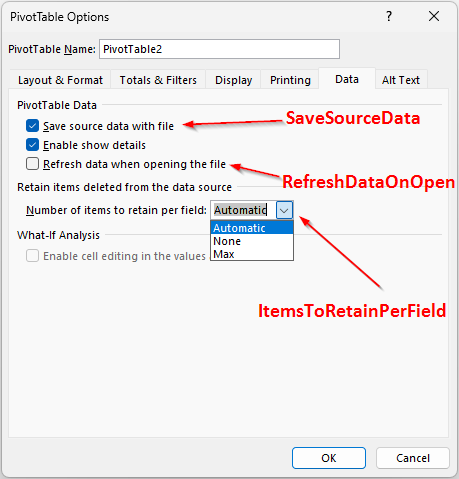Pivot tables
Pivot table is a tool that can summarize data from a range of cells and display summarized data in a second table that is called pivot table.
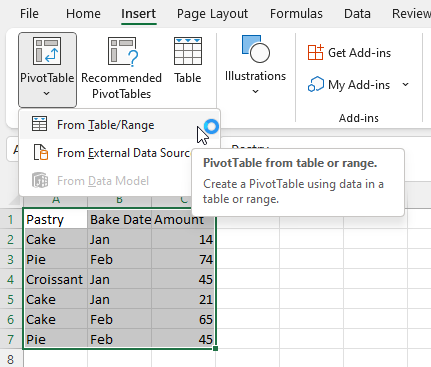
Pivot table structure
This chapter describes how is pivot table represented:
Pivot cache - a data store that contains all values from the source range.
Pivot table - a table in a workbook that displays summarized data from the pivot cache.
Pivot fields - a row or column in a pivot table. In most cases, it is a representation of a column from the cache, but it cann be also a part (year, month, day) of a date column.
Pivot value fields - values displayed in a data area of a table.
Pivot Cache (IXLPivotCache)
Pivot cache stores a copy of data from the original data source. It is a cache and the data are not updated automatically, user has to call IXLPivotCache.Refresh() to update them. Each column in the original source represents a field that can be displayed in a pivot table.
One pivot cache can be used by multiple pivot tables. That allows for a different summarization of a underlaying data without an expensive data duplication.
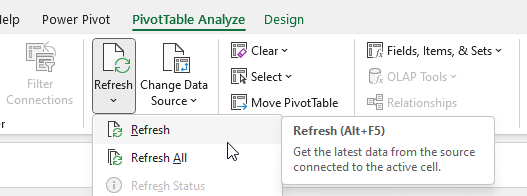
All pivot caches in a workbook are accessible through XLWorkbook.PivotCaches collection. The cache for a specific pivot table can be retrieved through IXLPivotTable.PivotCache property.
Pivot Table (IXLPivotTable)
Pivot table transforms data from the pivot cache to display a summary information. Pivot table takes data from a some fields from the cache and uses them to display the data in a tabular form.
The rows/columns of the pivot table contain distinct values of the row/column fields and the value fields contain calculated values (e.g. sum or average) of all values in a cache that belong to the record that contains values of respective row/column in the pivot table.
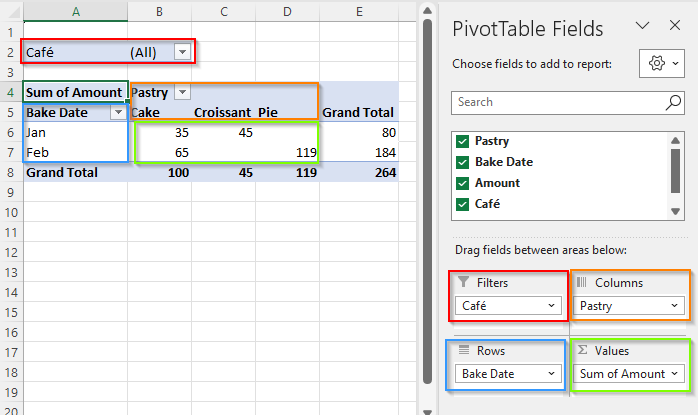
All pivot tables for a worksheet are accessible through IXLWorksheet.PivotTables collection.
Row/Column Fields (IXLPivotField)
Row/Column pivot table fields of a pivot tables contain a distinct values from the pivot cache for their field. The values are displayed across the axis of the field.
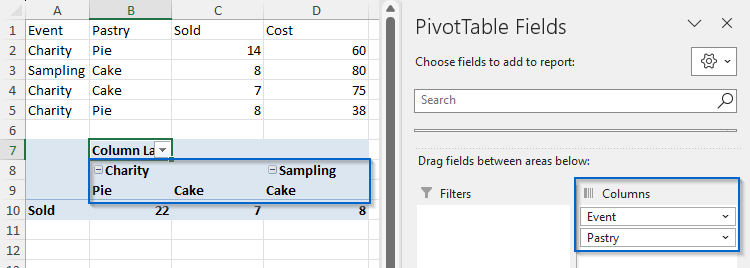
Notice that only distinct values are displayed and also only the combination that exist in the cache. There is no “Sampling”, “Pie” columns, because there is no such row in the cache and thus no summarization can be done for such values.
Row/Column pivot field determines
order in which are values displayed in a row/column of a pivot table
which values are shown and which are hidden in a row/column of a pivot table
whether subtotals should be shown for a field values and how should subtotals be calculated.
Row fields of a pivot table are stored and can be added/deleted in the IXLPivotTable.RowLabels collection and column fields in IXLPivotTable.ColumnLabels collection.
Value Fields (IXLPivotValue)
Value pivot table fields are display data in a summarized form. It determines
How should the value of a data cell be summarized (e.g. sum or count)
How should the values be shown to the user (e.g. directly as a value or as a difference from previous value)
Value fields are stored and can be added/deleted through IXLPivotTable.Values collection. The calculation method for the field can be set through IXLPivotValue.Calculation property.
Report Fields (IXLPivotField)
Report fields are used to filter all data in a pivot table. They are stored in a IXLPivotTable.ReportFilters collection. Although they also use IXLPivotField interface, many properties don’t do anything.
Pivot Styles
Pivot table can be stylized. The styling is a made out of a collection of tuples area-style. Each cell of a pivot table is is evaluated against a list of conditions and if cell satisfies all conditions, the style is applied to the cell (multiple styles can apply and be composed). Conditions are varied, e.g.
Is cell in a column fields area?
Does cell lie on a row of a specific field?
Is the field collapsed?
Does cell lie on a 3rd row of a field “Pastry”?
The conditions are dynamically evaluated and applied, e.g. when user collapses a row in the pivot table and conditions are reevaluated and styles reapplied.
Styles are set through IXLPivotField.StyleFormats. The style itself is set to the IXLPivotStyleFormat.Style property and conditions are set through other properties.
Basic usage
Classic pivot table
In order to create a pivot tables, you have to
Create a range (or a table) with data. Each column must have a text value that is used as a field name and values.
Add pivot table to the worksheet. Make sure there is enough space and don’t overwrite data in the original range. A common practice is to to place the pivot table to a new worksheet, like Excel does.
Add a label field to the pivot table row/column axis. The name of the field must be present in the pivot cache.
Add a value field to summarize the data and specify the summary formula that will calculate the displayed value. The default method is a sum, but it’s explicitely set in the sample for clarity.
Set labels, styles ect.
using var wb = new XLWorkbook();
var ws = wb.AddWorksheet();
var range = ws.FirstCell().InsertData(new object[]
{
("Event", "Pastry", "Sold", "Cost"),
("Charity", "Pie", 14, 60),
("Sampling", "Cake", 8, 80),
("Charity", "Cake", 7, 75),
("Charity", "Pie", 8, 38),
});
var pivotTable = ws.PivotTables.Add("pvt", ws.Cell(7, 1), range);
pivotTable.RowLabels.Add("Event");
pivotTable.ColumnLabels.Add("Pastry");
pivotTable.Values.Add("Sold").SetSummaryFormula(XLPivotSummary.Sum);
pivotTable.SetShowGrandTotalsColumns(false);
wb.SaveAs("pastry.xlsx");
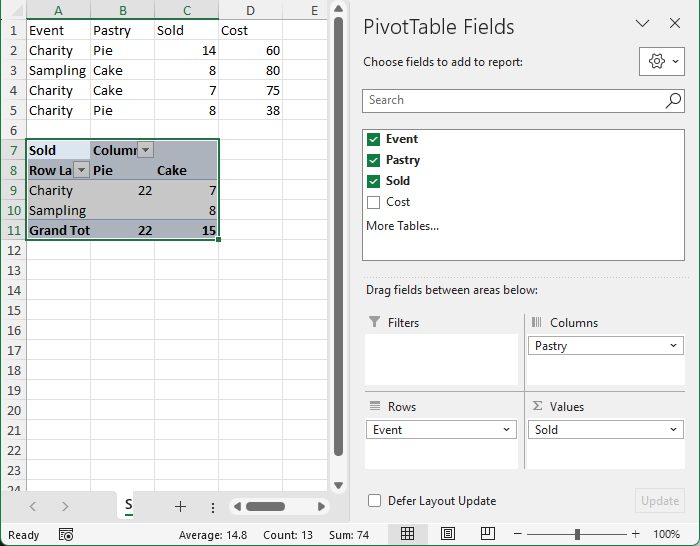
Labels only on one axis
It’s not necessary to set fields on both row and column axis. It’s enough to specify fields only on one axis and values fields. In such case, the columns will be the calculation of the value fields. Excel displays it as a Σ Values artificial field (see the screenshot).
using var wb = new XLWorkbook();
var ws = wb.AddWorksheet();
var range = ws.FirstCell().InsertData(new object[]
{
("Event", "Pastry", "Sold", "Cost"),
("Charity", "Pie", 14, 60),
("Sampling", "Cake", 8, 80),
("Charity", "Cake", 7, 75),
("Charity", "Pie", 8, 38),
});
var pivotTable = ws.PivotTables.Add("pvt", ws.Cell(7, 1), range);
pivotTable.RowLabels.Add("Event");
pivotTable.RowLabels.Add("Pastry");
pivotTable.Values.Add("Sold").SetSummaryFormula(XLPivotSummary.Sum);
pivotTable.Values.Add("Cost").SetSummaryFormula(XLPivotSummary.Sum);
pivotTable.SetShowGrandTotalsColumns(false);
wb.SaveAs("pastry.xlsx");
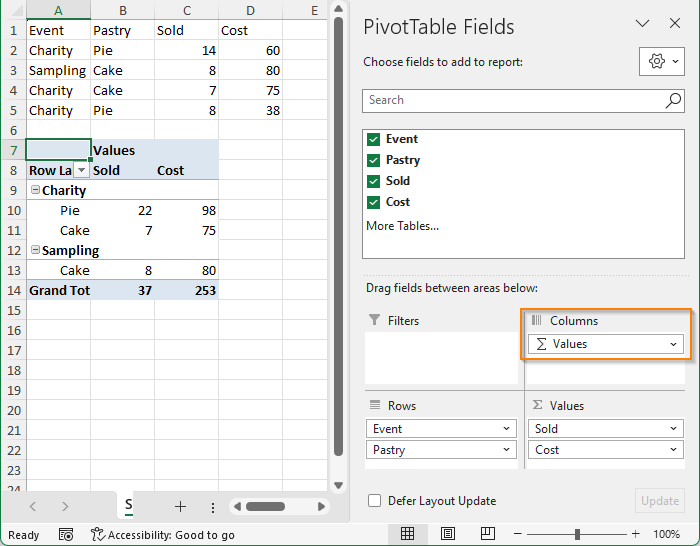
Pivot Table Cache
Pivot cache is a cache of data from a worksheet that are used to display the pivot table. Each column from the source range is represented by a field in the pivot cache.
Refresh
Data in the pivot cache are not updated automatically, when the data in a worksheet change. In order to update the data from the source, they must be refreshed. The content of the pivot table will be updated to reflect the new data. E.g.
If a field was removed, it is also removed from the pivot table.
Calculated values in the table can change.
Values across row/column axis can change.
Refresh data from the source through IXLPivotCache.Refresh() method.

If you need to refresh all pivot tables, iterate over the individual caches from XLWorkbook.PivotCaches and call IXLPivotCache.Refresh() individually.
Field names
Names of fields in a pivot cache can be retrieved from IXLPivotCache.FieldNames property. Every field name is unique string and field names are case-insensitive.
Field names are taken from top row of the source range. If value isn’t a string, it is converted to a string and used as a field name (e.g. number 12 will bu turned into a string 12).
If the source range contains potentially duplicate field names, the field names will be different in the pivot cache than in the range. That will be achieved by adding a number at the end of a field name, e.g. if there are two columns with name Cost, the pivot cache will contain field Cost and field Cost2.
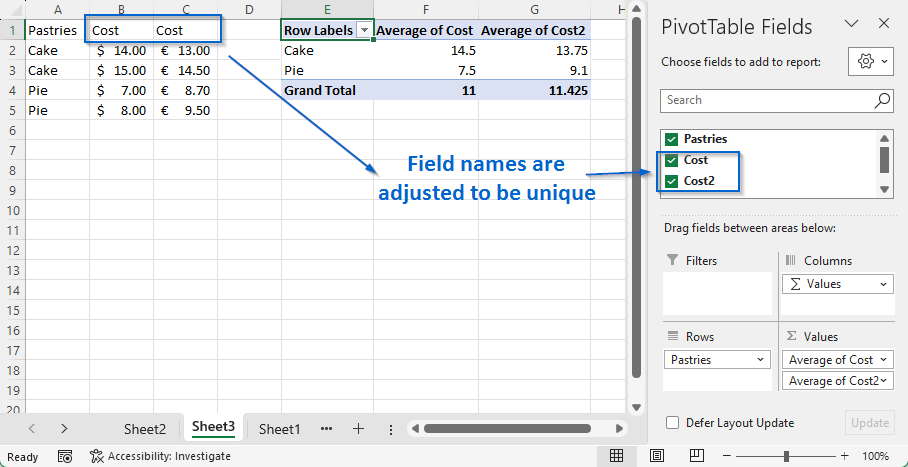
Options
IXLPivotCache can set options that affect what should Excel do with pivot cache.
IXLPivotCache.SaveSourceData - Should pivot cache be saved to the file? Saving data will cause file to be larger, but it will load faster. Also, the source of data might be an external workbook that might not be available in the future. Default is true.
IXLPivotCache.RefreshDataOnOpen - Should Excel refresh pivot caches and tables when it opens the workbook? Default is false, though Excel refreshes them anyway, because ClosedXML doesn’t save content of a pivot table properly at the moment.
IXLPivotCache.ItemsToRetainPerField - This option influences, whether field values should be shown in various filters of pivot tables, even after they were deleted from the source range and the pivot cache was refreshed. Example: Pivot table is updated with pastry sales each month. In some months, there won’t be any sales of strudel. Should strudel still be displayed in variosu filters as an option, even though it is not in the sales data? If the option is set to XLItemsToRetain.None, it won’t be an option in filters, because the ItemsToRetainPerField option says no to retain deleted items.
Options can be set through sheet Data of pivot table properties dialog.
